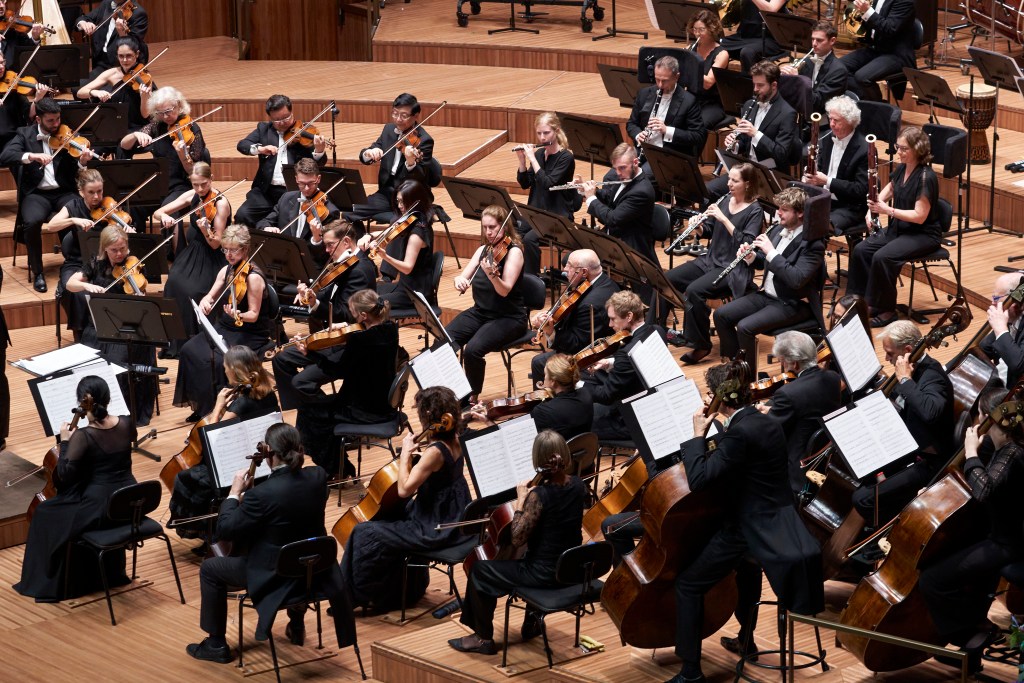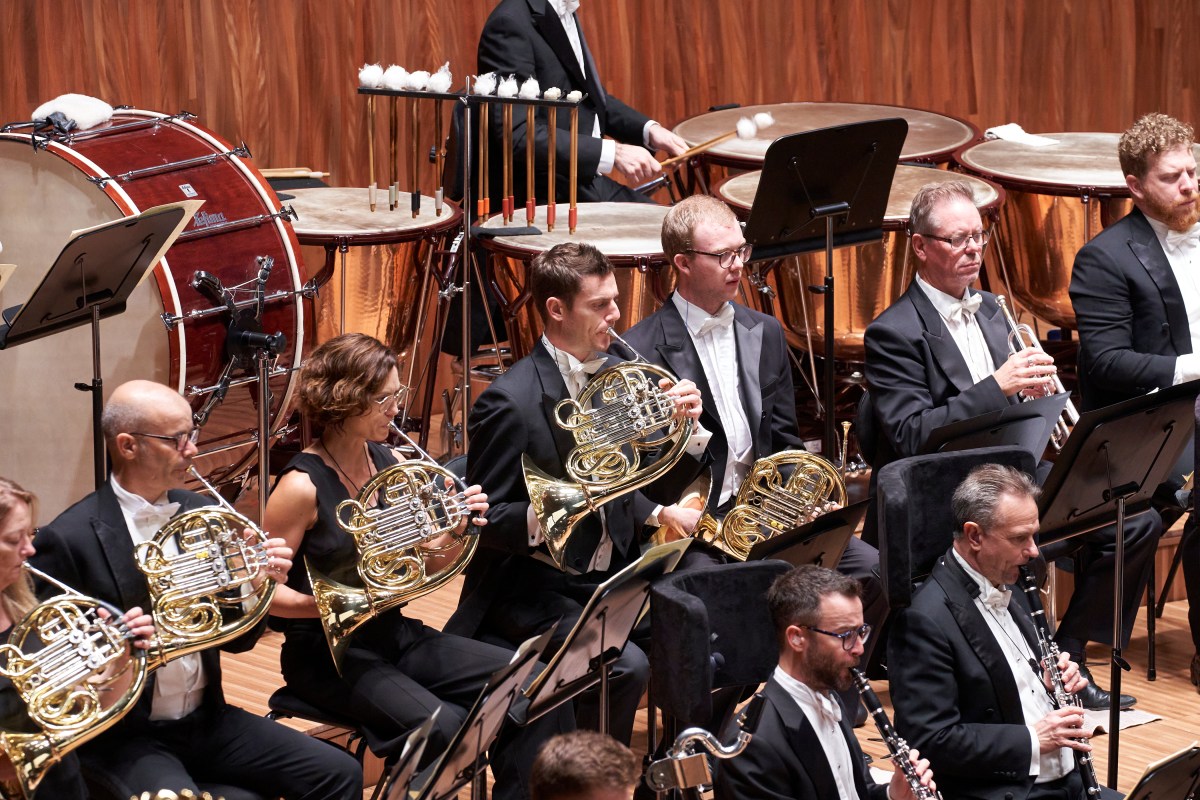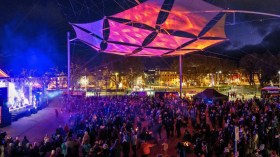For its opening Gala Concert of its 2024 season, Sydney Symphony Orchestra (SSO) under the baton of its Chief Conductor, Simone Young, gave us a modern composition in its Australian premiere alongside a trademark Mahler Symphony. The juxtaposition of these two works, in separate halves of the program, had much to recommend it, both having an intensity of instrumental colours across a sound palette of rich and diverse orchestration. Despite being completely different in style and written in different centuries, both works are informed by tragedy, examining human recovery from grief in profound and expressive musical ways.
The Concert commences with a heartfelt Rhythmic Acknowledgement of Country, that features First Nations percussionist Adam Manning alongside the orchestra. We are used to Welcome to Country tributes, but this is unique and refreshing: a rhythmic orchestral acknowledgment represented musically without words. Manning commences with evocative percussive clapsticks over low string chords, the whole gradually intensifying in sound. Orchestral single notes morph into a glorious synchronised harmony of clapsticks in a totally appropriate engagement with the land and its original peoples. It is a moving tribute.
Camille Pépin‘s Le Sommeil a pris ton empreinte was co-commissioned by the Orchestre National de France (ONF), Orchestre National de Lyon (ONL) and the SSO, and premiered in France in April 2023 with Simone Young conducting the ONF. A violin concerto, composed for virtuosic violinist, Renaud Capuçon, who repeats his performance here, the work was inspired by three poems of French poet, Paul Éluard. Centred on the theme of grief and loss in death with periods of mourning and eventual recovery, there is a strong recurring resonance with motifs of both sleep and love.
In just five short movements Pépin’s work offers a diverse palette of expressive colours and lush melodies with a stunning ethereal and at times quite breath-taking quality. Both impressionistic and rhythmically metallic and percussive, the work gives us sweeping melodies in the strings, deep undercurrents in both brass and woodwind, alongside complex harmonic resonances of bells, cymbals and keyboards. Her complex orchestration is as technically demanding and engaging as it is imaginative. The orchestra plays with great passion and commitment to give us a truly first-class rendition of the work.

The orchestral writing for the violin is also splendid and offers dramatic and atmospheric as well as melodious passages with finely crafted cadenzas that require the most virtuosic of playing. And in Renaud Capuçon we are treated to an exceptional talent, which he demonstrates across the full range of his beautiful instrument. From the sweetly phrased and most delicate, soft melodies through to the extraordinarily fast and furious dark passages, he displays a rare technical prowess and intense emotional sensibility. His cadenzas are awe-inspiring for their virtuosity and for the depth of tone that he is able to deliver.
Young conducts with a very strong, clear beat, marshalling her orchestral forces to wring every drop of emotion and expression from this powerful new work. A powerhouse on the podium, she gives much of herself to this piece, which she was clearly involved in commissioning and bringing to life.
Mahler’s Fifth Symphony is his most-loved and most-performed symphony, and was the first of his instrumental symphonies with no vocal component and no apparent clear structure. Its narrative across five movements groups them into three larger structural parts. A dark funeral march is followed by a stormy second movement. The second part moves to a considered Scherzo, which gives way to the celebrated Adagietto in the third part and ends in a surprisingly bright and joyful Rondo-Finale.
The works of Mahler show Chief Conductor, Young, at her absolute best, such is her affinity with the composer. She displays all the characteristics of the virtuosic conductor in this work. While many of us have heard this symphony many times before, Young gives it a freshness and a vitality that brings it vividly to life. She manages to imbue the work with such passion and commitment that we hear musical colours, individual instruments and delicate or dramatic phrasing and in a way that maybe we have not heard in the past.
It helps that the newly refurbished Concert Hall now has the most splendid and extremely live acoustic. Individual players and solo parts are clearly identified and enhanced, as are the orchestral sections across the whole of the Symphony. One could ask for a better sound quality than this anywhere. And the orchestra plays magnificently throughout, from the opening notes of the atmospheric trumpet fanfares through to the triumphant and huge sonority of the full orchestra at the end of the Rondo.
Review: Music review: Brooklyn Rider – The Four Elements, Melbourne Recital Centre
There is much to enjoy. The sharpness and precision of the strings, with some exceptional work from the violas and celli, and a marvellous sweetness from the violins. There are textured, colourful layers of sound from the woodwind, and some fine solos from flute, oboe, clarinet and bassoon. The horns are first-rate, with particular mention of the well-paced solo horn in the Scherzo. The brass comes into its own with excellent playing throughout, supported by strong percussion and timpani.
The Adagietto deserves special mention with breath-taking ethereal music from the harp, elegantly supported by the depth of longing displayed by the strings that brings tears to the eyes. The music swells and retreats beautifully under Young’s strong yet delicate baton. A marvellous interpretation.
This is an exciting and joyous night in the Concert Hall from an excellent SSO at the top of the players’ collective powers, led by an inspirational and assured Chief Conductor. With Young having just renewed her contract with the orchestra, we can look forward to many more first-rate concerts in this marvellous venue.
For more information. This concert is being repeated on 1 and 2 March.





